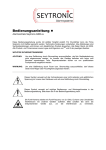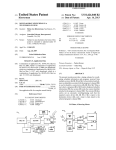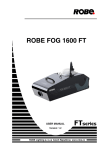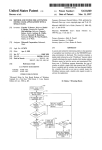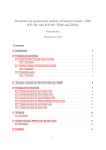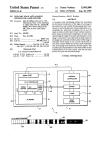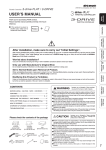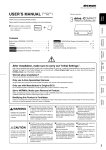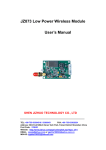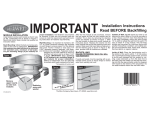Download `7\\I I /\ 4! 4` I
Transcript
United States Patent [191 Floyd et al. [54] SELF-REGULATING VALVE [75] Inventors: Terry S. Floyd, Clover, S.C.; Wyatt 4,493,444 [63] J un. 16, 1987 l/ 1985 .Del Bon et al. . 2603712 [73] Assignee: CEM Corporation, Matthews, NO [21] APP1- N°-= 868,171 8/1977 Fed. Rep. of Germany .... .. 137/859 OTHER PUBLICATIONS Abu-Samra et al., Analytical Chemistry, 47, 1475 (1975). Barrett et al., Analytical Chemistry, 7, 1021 (1978). Nadkarm, Analytical Chemistry, 56, 2233 (1984). M,ly 22, 1986 . 4,672,996 FOREIGN PATENT DOCUMENTS P- Barge", Jr" Matthews’ NC [22] Filed: Patent Number: Date of Patent: [11] [45] . Matthews et al., Bureau of Mines Technical Progress ' Related US. Application Data Contmuation of S61‘. NO. Apr. 11, Report 120 (Apr‘ 1983). Operation and Service Manual’ Microwave Drying aban- doned' /Digestion System, Model MDS-Sl, CEM Corpora [51] [52] Int. 01.4 ............................................ .. F16K 15/14 U.S. Cl. .................................. .. 137/522; 137/468; [53] Field of Search ................. .. 220/209; ZZZ/402.21, lion (revised M?r- 1985) Primmy Examiner_RObeI-t G. Nilson 137/859; 220/209 Attorney, Agent, or Firm-Timothy R. Kroboth 222/494; 137/496, 468, 859, 522 [57] ABSTRACT References Cited The present invention provides an improved valve. 115- PATENT DOCUMENTS the physical environment of the valve. This valve is [56] Th1s valve opens and closes in response to a change in 1,925,926 9/1933 Kunkel .............................. .. 222/494 2,854,996 10/1958 Hughes 2,942,614 6/1960 Lardner 3,160,329 12/1964 Radio . . . . . . . Particularly Suited as a relief valve in a microwave Sys ,, 137/859 x tem-based, closed vessel digestion procedure. This ..... .. 137/859 X valve includes a pressure-deformable, resilient wall . . . . . .. 137/859 X member having a ?uid vent port, and an obstructing 137/359 X “71/859 X member that cooperates with the wall member to open and close the valve. Also provided is a lidded vessel 41061I254 12/1977 Nikon-‘III: .................... .. 222/494 cludes a micmweve. system and this lidded vessel’ and 4,400,401 methods using this improved valve. 3,265,034 8/1966 Wagner 318041113 4/1974 Garcea ------ " gtfeizipard ‘ ' ' ' ' ''' employing this improved valve, an apparatus that in 8/1983 Beauvais at al_ ' 4,474,211 10/1984 Lucas. 4,474,314 10/ 1984 Roggenburg ..................... .. 222/494 10 Claims, 4 Drawing Figures ZZ 1” .92’ 74-’? /z i I I » ’7\\I I I 4! I 754/ WI / / 1'” I /4 4; I I /\ 4! 4’ I / ' a? , - . /\/ / __/-_--_é_—=\(=-:_?\ / Z4 :“I: __...__ | / / // I Z” U. S. Patent Jun. 16,1987 Sheetl of2 I1/", 4.1 a;:5 iM w ‘4,672,996 U. S. Patent Jun. 16,1987 Sheet2 of2 Z? id 4,672,996 1 4,672,996 2 web with openings offset from the apertures. The Beau SELF-REGULATING VALVE vais et a1 patent relates to a method using microwave energy for sterilizing and canning food products within This application is a continuation of application Ser. No. 722,266, ?led Apr. 11, 1985, now abandoned. a nonmetallic enclosure cover having an aperture con trolled by a check valve regulated by a weight. Within the enclosure cover, a non~metallic jar with a nonmetal lic lid having a vent hole closed by a vent closure, TECHNICAL FIELD contains the food product. The present invention relates to an improved valve. More particularly, this invention relates to a valve that opens and closes in response to a change in the physical environment of the valve, and that is especially useful as a relief valve. Furthermore, this invention pertains to a Also known in the prior art is a manually operated, dispensing valve formed by an opening in a metallic can lid top, a resilient rubber insert located inside the lid top and having an outlet port portion that extends through the lid top, and a plastic pin element. The plastic pin lidded vessel including this improved valve, and to uses of this valve. BACKGROUND ART element has a disc-like part with a raised portion that 15 seats against the rubber insert to close the valve, and has a pin-like part that extends through the outlet port por As exempli?ed by A. Abu-Samra et al., Analytical Chemistry, 47, 1475 (1975), and P. Barrett et al., Analyti cal Chemistry, 7, 1021 (1978), a microwave oven-based, digestion technique using an acid digesting agent in an tion of the rubber insert for engagement with a nozzle: The valve is opened by ?nger pressure exerted against the nozzle. Prior work known to us is a beryllium-copper spring, needle check valve of Lois B. Jassie and H. M. Kings open vessel, is known. Barrett et al. report that this procedure decreases digestion time, compared to a hot plate heat source. ton. This valve attaches to an outlet port of a closed digestion vessel, as a pressure relief valve for explosion prevention. Because the beryllium-copper spring does Also known, as illustrated by Nadkarni, Analytical Chemistry, 56, 2233 (1984), and S. A. Matthews et a1, 25 not absorb microwave radiation, this valve is usable in a microwave- system-based digestion procedure. How Bureau of Mines Technical Progress Report 120 (April ever, a drawback is that beryllium is oxidizable, espe 1983) is a microwave oven-based, digestion technique using an acid digesting agent in a closed system. In cially in an acid fume environment, to beryllium oxide, which results in the valve no longer being acceptable Nadkarni’s procedure, a covered Te?on ® or polycar bonate beaker was placed in a partially evacuated, 30 for use in a microwave system. Moreover, beryllium oxide is carcinogenic. closed, glass desiccator so that acid fumes leaking from the covered beaker were trapped within the glass desic cator. A polycarbonate bottle with a polypropylene screw cap was used as a closed digestion vessel by Mat thews et al., who cautioned against explosion caused by Therefore, there is a need for an improved valve that could be used as a pressure relief valve for explosion 35 prevention in a microwave system-based, closed vessel digestion procedure. Such an improved valve would be of even greater usefulness if it were self-closing after excess pressure had been relieved, and thereby could pressure build up within a closed vessel and observed leaking of some acid fumes around the bottle caps dur function as more than a one time pop-off valve. Such an ing pressure dissolution. Matthews et al. report that, improved valve would provide an even greater contri compared to open vessel digestion, closed vessel diges tion prevents the introduction of contaminating ele 40 bution to the art if it relieved pressure not only in re ments and the loss of volatile elements and compounds. sponse to a predetermined internal fluid pressure but also in response to temperature change. Such a valve Accordingly, although closed system digestion has would provide an improved apparatus for microwave been found to have advantages over open vessel diges tion, the containing vessel in a closed system could explode under pressure build up, with spewing of acid. The explosion hazard is enhanced, for example, if, as in tissue digestion, gas is generated by the digestion pro cess. As a result, open vessel digestion is commonly system-based, closed vessel digestion. 45 Moreover, an improved valve of this type would be especially advantageous if it could also be manually opened. This improved valve would be especially re markable if the components thereof could be of the utilized, particularly if the digestion process generates same non-metallic material. Furthermore, such an im gas. A lidded digestion vessel suitable for use in a micro proved valve would be of enhanced utility if it had a broad range of applications. wave system-based digestion that employs a corrosive digesting agent, is available from Savillex Corporation either with or without an outlet port in the lid. This lidded vessel is formed of a deformable, resilient, highly DISCLOSURE OF THE INVENTION It is accordingly an object of the present invention to 55 provide an improved valve that could be used as a pres chemically inert, thermoplastic material. This material sure relief valve for explosion prevention in a micro is a ?uorocarbon copolymer in which the carbon-?uo rine backbone in the main chain is connected with per wave system-based, closed vessel digestion procedure. ?uorocarbon copolymer is marketed by Dupont Corp. It is a further object of the present invention to pro vide an improved relief valve that is self-closing after excess pressure has been relieved, and thereby functions under the trademark Te?on ® PFA. as more than a one time pop-off valve. fluoroalkoxy side chains through oxygen links. This It is an even further object to provide an improved Prior art valves are exempli?ed by U.S. Pat. Nos. valve that relieves pressure not only in response to a 4,474,211 to Lucas, 4,493,444 to Del Bon et al, and predetermined internal fluid pressure but also in re 4,400,401 to Beauvais et al. The Del Bon et al patent is directed to a self-closing valve-and-lid assembly. The 65 sponse to temperature change. It is a still further object to provide an improved Lucas patent pertains to a valve that includes a disc-like apparatus for microwave system-based, closed vessel member through which apertures extend, and an aper digestion utilizing this valve. ture closing device having a pressure responsive flex 3 4,672,996 4 It is an even additional object to provide an improved valve the components of which may be non-metallic embodiments, and its several details are capable of mod i?cation in various respects, all without departing from the invention. Accordingly, the drawing and the de tailed description are to be regarded as illustrative in and of the same material. nature, and not as restrictive. It is an additional object to provide an improved valve of this type that can be manually opened. It is another object to provide an improved valve having a broad range of applications. Additional objects, advantages and novel features of the present invention are set forth in the description that follows, and in part will become apparent to those skilled in the art upon examination of the following description or may be learned by practice of the inven tion. The objects and advantages of the invention may be realized and attained by means of instrumentalities BRIEF DESCRIPTION OF THE DRAWING Reference is now made to the accompanying draw ing, which forms a part of the speci?cation of the pres ent invention, and which depicts preferred embodi and combinations particularly pointed out in the ap ments of an improved valve in accordance with the present invention and uses of the improved valve. FIG. 1 is an isometric view of the components of a lidded vessel employing a very highly preferred em bodiment of a valve in accordance with the present pended claims. invention; To achieve the foregoing objects and in accordance FIG. 2 is a cross-sectional view of the lid of the lid ded vessel of FIG. 1 along the line 2—2; with the purpose of the present invention, as embodied FIG. 3 is a sectional view of the assembled lidded and broadly described herein, there is provided a valve responsive to a predetermined internal ?uid pressure. 20 vessel and member 12 of FIG. 1 taken in a plane through the central assembly axis, showing the valve in This valve includes a pressure-deformable, resilient wall closed position and depicting contents in phantom member having a ?uid outlet port. The valve further includes an obstructing member engaged in a tight seal within the lidded vessel; and ing relationship with an inside surface of the wall mem FIG. 4 is a sectional view identical to that of FIG. 3, ber or with an inner surface of the outlet port. As a 25 except that the valve is shown in open position in re sponse to a certain ?uid pressure within the lidded ves result, out?ow through the outlet port is blocked when sel. internal ?uid pressure impinging on the wall member is insufficient to cause deformation thereof that over BEST MODE FOR CARRYING OUT THE INVENTION comes the tight sealing relationship. The wall member is sufficiently pressure-deformable that the force of the predetermined internal ?uid pres As explained earlier, the present invention is directed to an improved valve. More particularly, this invention relates to a self-regulating valve that opens and closes in response to a change in the physical environment of the valve, in particular to a change in internal ?uid pres sure. In a preferred embodiment, this improved valve is also temperature sensitive, and therefore able to re spond not only to internal ?uid pressure but also to sure acting thereon, causes deformation thereof that overcomes the tight sealing relationship, thereby open ing the valve to permit pressure relief through the outlet port. The resiliency of the ?uid pressure-deformed, wall member is suf?cient to cause the wall member to reen gage in the tight sealing relationship when internal ?uid pressure impinging on the wall member becomes less than the predetermined internal ?uid pressure, thereby temperature change. In this embodiment, the compo closing the valve. Accordingly, this valve opens and 40 nents of the valve can amazingly be made of the same closes in response to a predetermined internal ?uid material. Also in this embodiment, the valve is micro pressure. In a preferred embodiment, this valve is sensi tive not only to internal ?uid pressure but also to tem wave radiation transparent and is therefore useful as a perature. digestion technique, even when the digestion generates gas. In a very preferred embodiment, the improved valve is highly chemically inert and accordingly corro Also provided by the present invention is a lidded vessel that employs the improved valve of the present invention. In addition, there is provided an apparatus that in cludes a microwave system and a lidded vessel employ ing the improved valve of the present invention. In a preferred embodiment, the microwave system includes a corrosion resistant chamber, a corrosion resistant exhaust system capable of providing high volume air ?ow through the chamber, an element for absorbing excess re?ected radiation, and a computer-controlled variable power source. The lidded vessel is microwave transparent. Also provided by the present invention are methods using the improved valve of the present invention. relief valve in a microwave system-based, closed vessel 45 sion resistant. Also in a preferred embodiment, the im proved valve of this invention can be manually opened. Also as explained earlier, our invention is directed to a lidded vessel employing this improved valve, to an apparatus including a microwave system and this lidded vessel, and to methods using the improved valve. The term “?uid” as used in our description of the present invention and in the claims, means a liquid, gas or vapor, and the terms “upper”, “lower”, “above”, “below”, “upward” and “downward” are intended to designate relative orientation of the valve as shown in the Figures. FIGS. 1, 3 and 4 depict a lidded vessel 10 utilizing a These methods include use in canning a food product, 60 very highly preferred embodiment of a valve 12 in sterilizing an object, and dispensing a ?uid at a desired accordance with the present invention. Valve 12 is temperature. formed by a disc-shaped member 14, and a deformable, In the drawing and in the detailed description of the resilient top wall 16 of a lid 18 of a hollow receptacle or invention that follows, there are shown and essentially container 20. Centrally located in the lid is a ?uid outlet described only preferred embodiments of this invention, 65 port 22. Lid 18 includes an upright sleeve 23 that ex simply by way of illustration of the best mode contem tends the outlet port above wall member 16. plated by us of carrying out this invention. As will be Preferably, disc-shaped member 14 and the entirety realized, this invention is capable of other and different of lidded vessel 10 are formed of a deformable, resilient, 5 4,672,996 thermoplastic material, that is very preferably the same for each of member 14, the lid and the container. Even more preferably, this material is the ?uorocarbon co polymer described earlier. Preferably, the cross-sec tional thickness of disc 14 imparts semi-rigidity to the disc. Disc 14 has a peripheral wall surface 24 that con forms to an upper inside wall surface 26 of the lid, and enables the disc to be locked in place between the lid and an upper rim 28 of container 20. Encircling, and spaced apart from, a center 30 of the disc is a raised abutment ring 32 having a peak 34, which provides point contact between the disc and an inner surface 36 of lid top 16. As can best be seen in FIG. 1, located between ring 32 and peripheral wall surface 24 are aper tures 38, each having a ?ow area “A”, de?ned by a diameter “a”. With reference to FIG. 3, which shows valve 12 in closed position, the abutment ring peak of semi-rigid 6 Should the force of the internal ?uid pressure imping ing on the lid top again exceed the pressure of the abut ment ring against the lip top, valve 12 will reopen, until the ?uid pressure within the lidded vessel drops suf? ciently for the valve to reclose. Thus, opening and clos ing of the valve in response to the internal ?uid pressure within the lidded vessel, recurs as required. The internal ?uid pressure required to open valve 12 is controlled by factors including the height and the diameter of abutment ring peak 34, and the flexibility of the lid top. For example, the greater the height of peak 34, the relatively greater the pressure needed; the greater the diameter of the ring peak, the relatively greater the pressure required; and the more ?exible the lid top, the relatively less pressure needed. Accord ingly, by selection for example of an appropriate peak height or ring peak diameter, the valve can be made to open at a predetermined internal pfessure. Attention is invited to our later description, which disc 14 pushes against ?exibly deformable, lid top 16 so 20 illustrates the relationship between diameter of the ring as to cause the lid top to bulge outwardly. Outward bulging of the lid top is seen by comparison to the undis torted lid shown in FIG. 2. The point contact provided by the abutment ring peak produces a tight sealing rela tionship between ring 32 and inner lid top surface 36. Peak 34 is appropriately spaced apart from center 30 of the disc such that it surrounds outlet port 22 of the lid, thereby obstructing ?ow through the outlet port. The outlet port and abutment ring could be offset from the central assembly axis, provided that they are so peak and the internal pressure needed to open valve 12. As described later, valve 12 is responsive not only to internal ?uid pressure but also to temperature change. If disc 14 were ?exible, rather than semi-rigid, the 25 disc would be seen bowed downwardly in FIG. 3 and lid top 16 would show less outward bulging. For a constant height of peak 34 and diameter of ring 32, a relatively higher internal pressure would be needed to open valve 12, if the disc were ?exible, rather than semi-rigid. If, on the other hand, the disc were rigid located relative to one another in the assembled valve, rather than semi-rigid, internal pressure pushing against that the abutment ring peak surrounds the outlet port. central area 43 of the lower disc surface would not As shown in FIGS. 3 and 4, disc 14 divides lidded vessel 10 into compartments 40 and 42. Apertures 38 permit internal fluid pressure to be equally exerted against lid top 16 and other walls of the lidded vessel. The number of apertures, whether one or many, is not strengthen the tight sealing relationship between peak 34 and inner top surface 36. When the disc is ?exible, the internal pressure required for valve opening is less predictable than when the disc is rigid or semi-rigid. When used with a lidded vessel, valve 12 is operable regardless whether a small volume of liquid is used, or the lidded vessel is ?lled to capacity. critical; rather, the sum of areas “A” of the apertures should not restrict ?ow to the cap. So long as the force of the internal fluid pressure 40 Advantageously, valve 12 can be manually opened by exerting ?nger pressure against an outer wall 47 of acting on lid top 16 is less than or only equal to the sleeve 23 in a direction generally perpendicular to the pressure of abutment ring 32 against the lid top, valve 12 remains closed. Internal ?uid pressure pushing central assembly axis of the valve. This type of ?nger pressure will move inner lid top surface 36 out of the assists the mechanical pressure exerted by the abutment 45 tight sealing relationship with the abutment ring peak. Valve 12 can be maintained open by pressure exerted ring to strengthen the tight sealing relationship between through the outlet port on an upper disc surface 48. peak 34 and inner top surface 36. Hence, the force of FIGS. 3 and 4 depict lidded vessel 10 containing in internal ?uid pressure is utilized to enhance closure of phantom, solids 49 and a liquid 50, to which microwave the valve. Central area 43 is de?ned by a diameter “f” of 50 energy is applied by means of a microwave 51, also the abutment ring peak. shown in phantom. Solids 49 may be, for example, a A donut-shaped area 45, which consists of the area of sample to be digested such as a gas-generating tissue inner lid top surface 36 outside the abutment ring peak, sample. In this case, liquid 50 would be a digesting agent is conveniently greater than central area 43. Since the such as an acid digesting agent. Solids 49 may also be a lid top is more ?exible than the disc, central area 43 55 food product to be canned using microwave energy, in could be greater than area 45. which case liquid 50 would contain water; or solids 49 If, as illustrated in FIG. 4, the force of the internal may be objects to be sterilized using microwave energy, ?uid pressure impinging on lid top 16 should exceed the in which case liquid 50 would include water. pressure of abutment ring 32 against the lip top, the lid To take advantage of the manual release feature of top is lifted away from sealing contact with abutment valve 12, lidded vessel 10 could contain a ?uid to which ring peak 34, and valve 12 is opened. A gap 46 is created microwave energy is applied to heat the ?uid and build between peak 34 and inner lid top surface 36, through up internal pressure for manual release of the warm or which pressure is released from the lidded vessel, via hot ?uid. Exemplary ?uids include, but are not limited ?uid outlet port 22. to, a gas, a foam, a semi-?uid mixture such as a slurry, or When a suf?cient reduction in the force of the inter nal ?uid pressure acting on the lid top has occurred, the 65 a liquid such as a semi-solid or an emulsion. Illustrative semi-solids include gels and pastes. resiliency of deformable, resilient top wall 16 causes For example, container 20 could be filled with a suit disc 14 and inner lid top surface 36 to reseat in a tight able shaving cream composition, and the lidded vessel sealing relationship, thereby closing the valve. against a central area 43 of a lower disc surface 44, 7 4,672,996 8 assembled with disc-shaped member 14 in place. The internal pressure. In comparison, if the diameter across contents of the assembled vessel could then be heated the ring peak is 2 inch, the valve opens at approximately 80 psi internal pressure, and if the ring peak diameter is 5,1 inch, the valve opens at about 95 psi internal pressure. by microwave radiation for a desired period of time. The lidded vessel could then be inverted, and valve 12 A valve in accordance with the present invention in manually opened to release a warm or hot shaving cream composition. It will be appreciated that the lid which the pressure-deformable, resilient wall member is ded vessel is re?llable, as the lid could be removed and additional material could be added to the container for made of a thermoplastic material, is not only pressure sensitive but also temperature sensitive: as the tempera dispensing or discharge. ture of the pressure-deformable wall member increases, elasticity of the material thereof increases, and the valve It will be noted that the ?uid pressure opening valve 12 is in the same upward direction as the mechanical opens at a relatively lower pressure. For example, as pressure being exerted on deformable lid top 16. just described, when the disc of valve 12 has a ring peak diameter of % inch, the valve opens at about 60 psi for water. In this instance, vapors within the lidded vessel, Preferably, the same material is used to form all com ponents of our improved valve. As a result, one valve component will not become hotter than another valve component. The containers of the lidded vessels of result in top wall 16 of the lid being at a temperature of approximately 150° C. In contrast, if a liquid were used FIGS. 1 and 3-6 are preferably formed of the same having a boiling point appropriate for producing a lid material as the pressure-deformable wall member, which results in a vessel-protecting effect. However, in some applications, a valve in accordance with the pres 20 ent invention is used with a container formed of a differ ent material. For example, the valve could be formed of top temperature of about 60° C., the valve would open at approximately 110 psi internal pressure. When using valve 12 for closed vessel digestions, the manual opening feature of the valve makes it possible to check for high pressure within the closed vessel, prior thermoplastic components, but the container could be formed of glass. ple. to opening the closed vessel to remove a digested sam For use in a microwave system, the improved valve 25 of the present invention should be microwave radiation transparent. This characteristic is achieved if the valve is made of a microwave transparent, thermoplastic ma digesting agent fumes may escape. However, when the digestion generates a gas, opening and reclosing of the valve will be bene?cial. terial. Preferably, the same material is used to form all valve components. Exemplary microwave transparent, In carrying out a closed vessel digestion, it will gen erally be undesirable for the relief valve to open, as 30 As can be seen, a valve in accordance with the pres thermoplastic materials include, but are not limited to, ent invention, is capable of containing a high pressure, polypropylene, polyethylene, polypropylene/polyethy that is, a pressure of more than about 50 psi. Accord ingly, the improved valve makes possible a closed ves lene copolymers, and the ?uorocarbon copolymer de scribed earlier. The ?uorocarbon copolymer advanta geously provides a high temperature, corrosion resis 35 lidded vessel walls being an important limitation on the tant valve. As later described in more detail, a valve in accor out of a bottom wall of a Savillex lidded digestion vessel sel digestion at high pressure, with the strength of the internal pressure. For example, we experienced a blow dance with the present invention is temperature sensi at about 150 psi. In contrast, the prior art, closed vessel tive when the pressure-deformable wall member thereof digestion procedures described earlier, experienced is made of a thermoplastic material. Illustrative thermo 40 leakage at considerably lower pressures. High pressure plastic materials for providing a temperature sensitive digestions should further reduce digestion time. valve include those just described. Advantageously, a A thermoplastic lidded vessel such as vessel 10 may be heat treated to reduce deformability of the walls useful thermoplastic material is moldable and precision machinable. thereof. Heat treating or annealing is carried out at an An eminently useful microwave system for digestion 45 appropriate temperature for a suitable period of time to obtain walls having the desired reduced deformability. procedures is characterized by a corrosion resistant interior chamber, a corrosion resistant exhaust system capable of providing high volume air ?ow through the chamber, means for absorbing excess re?ected radia tion, and a computer-controlled variable power source. A microwave system of this type is commercially avail able under the trademark MDS-8l from CEM Corpora tion, Matthews, N.C. Further details of the present invention are now pro vided based on trials carried out in an MDS-8l micro wave system, using a valve in accordance with the present invention as a relief valve for a lidded digestion For example, lidded vessel 10 could be heated at about 200° C. for about 72 hours. The self-regulating valve of the present invention can be also used with a microwave system for enabling chemical starting materials to be reacted at a desired pressure and temperature, and dispensing or discharg ing the reaction product at a desired temperature; or for simply dispensing or discharging a ?uid at a desired temperature. Exemplary ?uids include, but are not lim ited to, a gas, a foam, a semi-?uid mixture such as a slurry, or a liquid such as a semi-solid or an emulsion. vessel obtained from Savillex Corporation. Water is Illustrative semi-solids include gels and pastes. Use of the valve for dispensing or discharging a ?uid at a de added to the vessel, the lid of which is provided with a vent port, and the lidded vessel is assembled with semi 60 sired temperature avoids the need for temperature-sens rigid, disc-shaped member 14 in place, to form valve 12. ing devices and related temperature-actuated devices. Member 14, which is made of the thermoplastic ?uoro The manual release feature of, for example, valve 12 carbon copolymer described earlier, has an abutment may also be used for discharging, for purposes of illus ring peak that is 0.062 inch high, and four apertures tration, a pressured ?uid, such as grease, from a hose or equally spaced around the abutment ring each with a 65 conduit, on one end of which disc-shaped member 14 diameter of 5 inch. The lower disc surface has a diame and a closure element are in place. ter of 1.53 inches. When the diameter of the abutment In the preceding description of the present invention, there are shown and essentially described only pre ring peak is % inch, this valve opens at about 60 psi 9 4,672,996 10 pingement-enabling means being located between said abutment and said peripheral wall surface; ferred embodiments of this invention, but as mentioned above, it is to be understood that the invention is capa ble of changes or modi?cations within the scope of the wherein said dome-shaped wall member comprises inventive concept expressed herein. Several changes or modi?cations have been brie?y mentioned for purposes of illustration. means for manual relief of internal ?uid pressure, said means for manual relief being a sleeve integral with said dome-shaped wall member, that extends said outlet port above said dome-shaped wall mem INDUSTRIAL APPLICABILITY ber; The improved valve of this invention is useful as a wherein said dome-shaped wall member is suf? ciently ?uid pressure-deformable that said certain internal ?uid pressure acting thereon, breaks said valve seal to permit out?ow through said outlet port; and wherein the ?uid pressure-deformed, wall member is sufficiently resilient that said valve seal is reformed when internal ?uid pressure becomes less than said relief valve, for example, in a microwave system-based, closed vessel digestion procedure. Further uses of the valve in combination with a microwave system, include canning a food product, sterilizing an object, or dispens ing a ?uid such as a gas, a foam, a semi-?uid mixture such as a slurry, or a liquid such as a semi-solid or an emulsion. We claim: 1. A self-opening and self-closing relief valve for certain internal ?uid pressure. 2. The relief valve of claim 1, wherein said abutment providing ?ow out of a closed system in response to a support member is semi-rigid. certain internal ?uid pressure, said relief valve compris 3. The relief valve of claim 1, wherein said abutment support member is a disc-shaped element. 4. The relief valve of claim 1, wherein said abutment mg (a) a dome-shaped, pressure-deformable wall member having an outlet port, and (b) an abutment integral with a support member is ring-shaped. 5. The relief valve of claim 1, wherein said abutment support member is formed of a thermoplastic material. 6. The relief valve of claim 1, wherein said dome shaped wall member is formed of a thermoplastic mate rial, whereby said relief valve is also temperature sensi tive. 7. The relief valve of claim 1, wherein said dome shaped wall member and said abutment support member are formed of the same thermoplastic material. 8. The relief valve of claim 7, wherein said thermo therefor, said abutment being spaced apart from a center of said support member and having a cir cumferential peak adapted to surround said outlet port and forming a valve seal with an inside surface of said dome-shaped wall member when internal ?uid pressure impinging on said dome-shaped wall member is insufficient to break said valve seal; wherein said dome-shaped wall member is an integral part of a closure element, and said abutment sup port member has a peripheral wall surface that is adapted to interlock with, and that is in an inter 35 plastic material is moldable and precision machinable. 9. The relief valve of claim 1, wherein said dome locking relationship with, an inside wall surface of shaped wall member is an outer wall member. said closure element; 10. The relief valve of claim 1, wherein said closure wherein said abutment support member comprises element is a lid. means for enabling internal ?uid pressure impinge * * l‘ * ii ment on said dome-shaped wall member, said im 45 55 60 65 UNITED STATES PATENT AND TRADEMARK OFFICE CERTIFICATE OF CORRECTION PATENTNO. : 4,672,996 DATED : June 16, 1987 INVENTOFHS) : TERRY s . FLOYD It is certified that error appears in the above-identified patent and that said Letters Patent is hereby corrected as shown below: On the Title Page, Item [191 "Floyd at 81- Should read —- Floyd -.-. Item [75] Inventors, should read [75] Inventor: -- Terry S. Floyd ——. Signed and Sealed.v this Twelfth Day of January, 1988 Attest: DONALD J. QUIGG _ Arresting O?‘icer - Cammissioner of Patents and Trademarks









